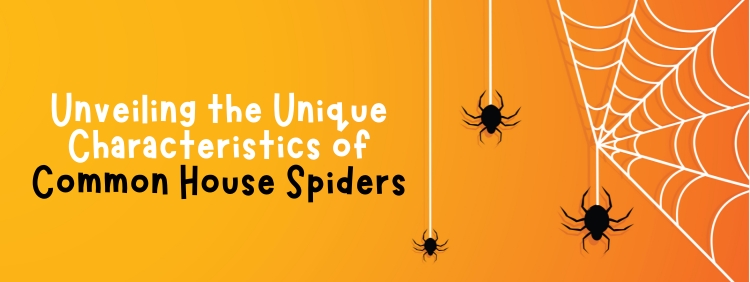 Have you ever been startled by a spider dashing across your living room? Or perhaps you've discovered a cozy cobweb tucked away in a quiet corner of your Kitchener home and wondered how to get rid of spiders?
In this article, we will learn about the most common house spiders you might encounter and the best options for pest control in Kitchener. By the end of this post, you should be well-equipped to navigate your home's pest ecosystem with knowledge and confidence.
Have you ever been startled by a spider dashing across your living room? Or perhaps you've discovered a cozy cobweb tucked away in a quiet corner of your Kitchener home and wondered how to get rid of spiders?
In this article, we will learn about the most common house spiders you might encounter and the best options for pest control in Kitchener. By the end of this post, you should be well-equipped to navigate your home's pest ecosystem with knowledge and confidence.
Understanding House Spiders
Living in close association with humans, house spiders know how to blend well with their environment. But what actually makes them so adaptable to our homes, and why are they often found in your living space?Biology
Biology-wise, house spiders belong to the larger family of spiders known as Araneidae and can adapt to different climatic conditions. While they prefer warm, dry environments, they can survive in cold and rainy climates too. As nocturnal creatures, they are active mostly at night, during which they either repair their web or hunt for food. Most can live up to a year, with females outliving males. Their diet mostly consists of insects, which they capture using their intricate and sticky webs. Surprisingly, they are also known to indulge in cannibalism, especially when food is scarce.Physical Characteristics
With a variety of physical features, spiders can be identified by their unique characteristics. The size of house spiders can vary greatly, with adult females often larger than males. They can range from just a few millimetres up to 1 cm in body length. The colour typically ranges from yellowish-brown to dirty gray, with distinct patterns on their body or legs.- Body structure: House spiders have two main body parts: the cephalothorax (head and thorax combined) and the abdomen. They also have eight legs and eight eyes which are usually arranged in two rows.
- Spinnerets: They have three pairs of spinnerets at the end of their abdomen, which produce silk for making webs.
- Pedicel: The pedestal, a small, thin, flexible region, connects the cephalothorax and the abdomen of spiders. This feature distinguishes them from other arachnids.
Mating Behavior
The mating process involves a high degree of risk for the males. But it also provides an intriguing display of their cautiousness and tenacity. Males are often seen performing a range of complex maneuvers to avoid getting eaten by the females. This involves a series of vibratory signals, a careful approach to the female, and rapid retreats. After mating, the female produces an egg sac, which contains hundreds of eggs. The female carries this sac around, protecting it until the spiderlings hatch and disperse. In a nutshell, understanding biology makes it easier to identify them and understand their behaviour. This knowledge also aids in effective pest control measures, keeping our homes a comfortable and a pest free space.Identifying House Spiders In Your Home
House spiders can be more elusive than you might imagine. And while we mostly want to avoid them, knowing how to identify them in your home is crucial. This section will guide you on what to look out for in your quest to unearth these silent co-habitants.The Web Structure
One distinctive characteristic is the type of web they build. Most construct tangled cobwebs, which are erratic and disorganized in design. If you notice these in your home’s corners or furniture gaps, that’s a hint you're dealing with a common house spider. However, keep in mind not all use webs; some are hunting spiders and would not weave webs at all.External Features
House spiders have a variety of external features you should be on the lookout for. Observe their colouration; they generally have a combination of brown, gray, black, and white colour patterns. They tend to have elongated bodies and spindly legs. A more specific attribute is their abdomen shape. House spiders typically have a round, globular abdomen.Behavioural Patterns
Certain behaviours can further support your identification. For instance, these arachnids typically prefer to remain in their webs, with little movement. This is in stark contrast to hunting spiders, which are typically more mobile and less web-dependent. So, if you notice one that seems more comfortable in its web, it could be a house spider.
Preventing a Pest Infestations
Keeping house spiders at bay involves more than just routine cleaning. It demands a proactive approach and strategic interventions both inside and outside your home. To aid you in this endeavour, we've compiled some effective measures to prevent infestations in Kitchener.Block Entry Points
The first step to preventing any pest infestation is to make it harder for them to gain access to your home. Spiders can enter through cracks and crevices in the walls, space around windows and doors, vents, and other small openings.- Regular inspection: Look for and seal off as many potential entry points as possible. Regular checks of the building’s exterior for cracks or crevices that could serve as entry points are recommended.
- Door sweeps: Install door sweeps and repair any broken screens to close off these potential entry points. Brush or rubber door sweeps are quite effective in providing a physical barrier against crawling pests.
- Sealants: Use a good quality, weather-resistant sealant to fill the gaps.
Reduce Outdoor Attractions
Attractions like light and food sources in your yard can lure spiders close to your home, increasing the likelihood of them finding their way in. Here are some ways to reduce these attractions:- Lighting: Spiders aren't attracted to light, but the insects they prey upon are. By changing outdoor lighting to yellow bulbs or sodium vapour lamps, you can reduce the number of insects around your home.
- Declutter: Removing piles of wood, compost heaps, or garden waste from near your home reduces the number of places spiders can hide.

